When we last left our heroes, they were eagerly anticipating exploring the grounds of their temporary home the next day. We cut from that to Lucy staring out the window at the thickly falling rain. Ironic changes of scene aren’t a very original idea, but the book practically giftwrapped that one for the filmmakers. Meanwhile Susan is quizzing her brothers from a huge dictionary while Peter slumps in a chair, bored, and Edmund slumps under a chair, bored.
Susan: Gastrovascular. (Pause) Come on, Peter! Gastrovascular.
Peter: Is it Latin?
Edmund: Is it Latin for worst game ever invented?
In my last post, I described the movie in a somewhat finger-wagging tone as not using much of the book’s dialogue, so it’s only fair to say that I think that conversation works better than the one between Edmund and Susan at this point in the text as it allows the viewers to infer what’s happening for themselves (Edmund is bored and Susan is unsuccessfully trying to help him entertain himself) instead of just spelling it out for them.
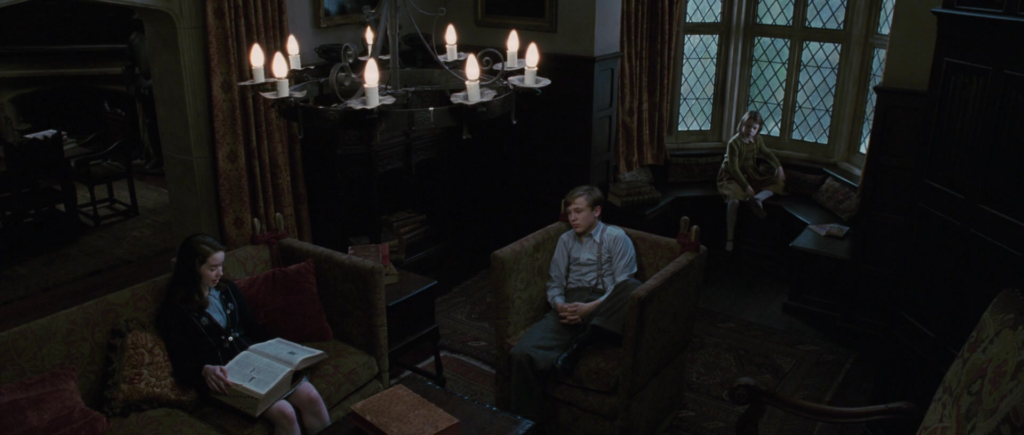
Anyway, Susan slams the dictionary shut with a frustrated sigh. Lucy suggests they play hide and seek. Judging by everybody’s reactions, that’s a game that she likes but no one else in her family does. “But we’re already having so much fun,” says Peter sarcastically. “Come on, Peter! Please! Pretty please!” says Lucy, giving him the puppy dog eyes. I feel like William Mosley and Georgie Henley kind of overplay their lines in that exchange. Peter’s line in particular would benefit from a dryer, less elaborately sarcastic reading. Anna Popplewell and Skandar Keynes have better comic timing. Nevertheless, all four actors are great in this movie.[1]And, incidentally, I have to praise the movie for getting right that some of the Pevensies have dark hair and some golden hair even though it’s supposed to be Lucy with the latter, not Peter.
Despite Lucy being in the minority, the kids play hide and seek with Peter being “It.” This is a change from the book where they explore the house at this point and play hide and seek later (with Susan being “It” by the way.) Part of me regrets that alteration as exploring a huge house like the professor’s was my dream as a kid, but I understand the reasoning behind it. Having Lucy search for a hiding place gives her a more understandable reason for going inside a wardrobe than if she was just exploring.[2]Though you could also argue that it’s thematically significant that Lucy is the only one of her siblings who thinks it worth looking in something so seemingly plain and ordinary. And, hey, we still get a nice little montage of the house. The set design works great even if it doesn’t use many details from the book at this point.
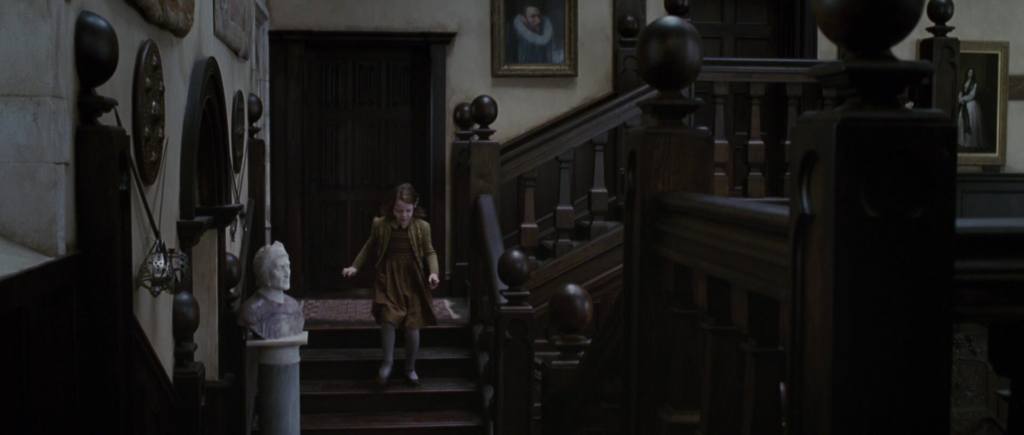
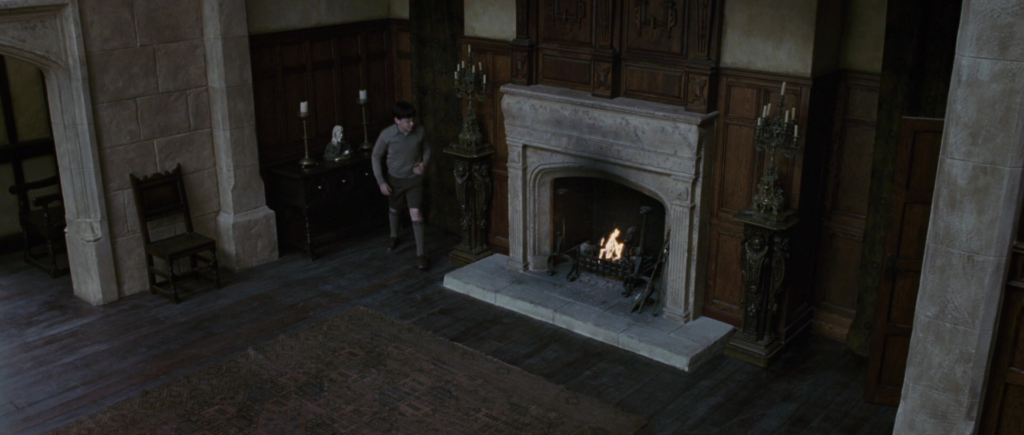
Susan hides in a window box. Lucy races toward a curtain but Edmund pushes his way in front of her and then claims that he got there first, further establishing himself as a jerk and one who’s less mature than he claims to be. Lucy runs down a hallway and tries two doors unsuccessfully before finding one that opens. In a later scene in the book of circumstances forcing the children to take refuge in the fateful wardrobe, C. S. Lewis describes it as if “some magic in the house had come to life and was chasing them into Narnia.” The other doors being locked here and even Edmund hogging a hiding place have a similar effect though I’m a bit confused about the layout of the house.
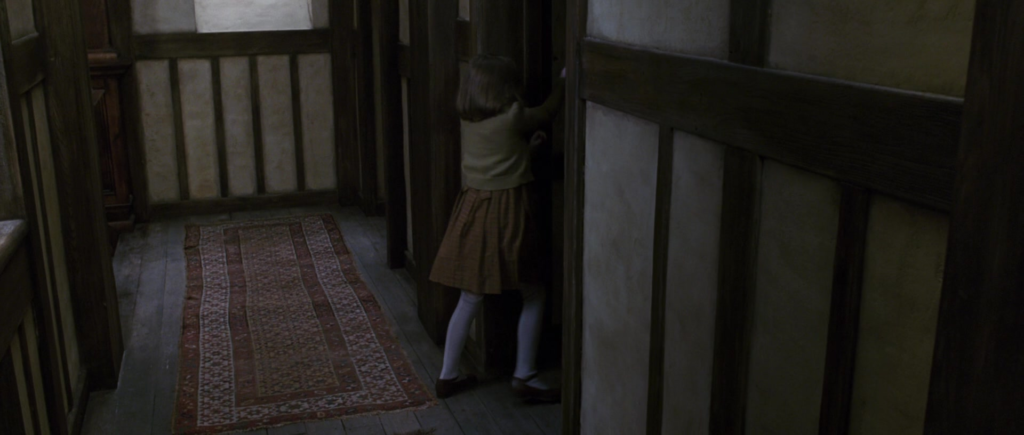
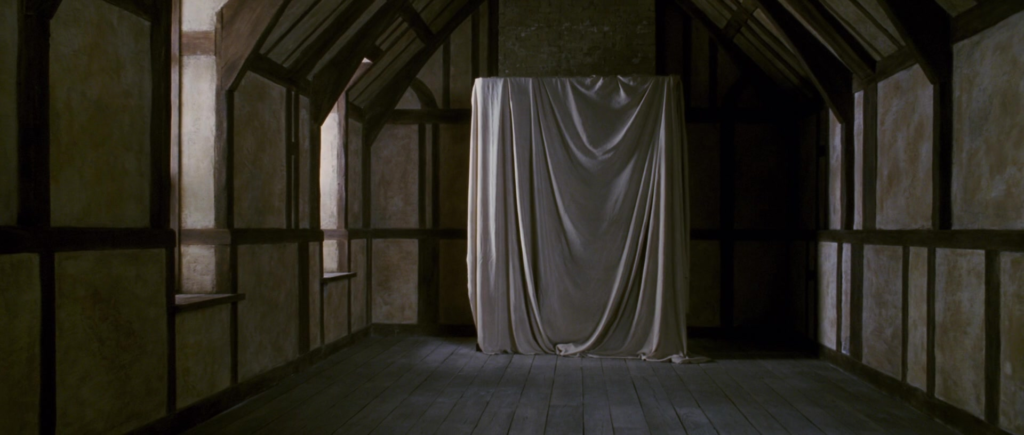
This hide and seek montage is accompanied by “Oh, Johnnie,” a song from the 1940s by the Andrews Sisters,[3]Longtime readers of this blog may have already heard of them. adding to the period feel. As Lucy enters the nearly empty spare room, the song fades away, appropriately as we are now leaving the “period” portion of the story and moving into the fantasy portion. The scene, which has been fast paced thus far, slows down as Lucy walks over to the object at the end of the room and removes the dustcloth, revealing a big wooden wardrobe. It’s obvious that something momentous is going to happen and you could argue that it would be better if the movie were a little more nonchalant about the whole thing and we related more to Lucy’s shock when something magical happens in a minute. But I won’t argue that. As someone who knows what’s going to happen and what a big deal it is, I love this scene as it is. The music is really spinetingling. Uncharacteristically but in keeping with the scene’s slow pace, the movie treats fans to a couple of minor details from the book they wouldn’t expect to be included. There’s a half dead bluebottle on the room’s windowsill and when Lucy opens the wardrobe door, a couple of mothballs roll out. Of course, the bluebottle was entirely dead in the book, and it was only two mothballs, not three, but who’s counting?

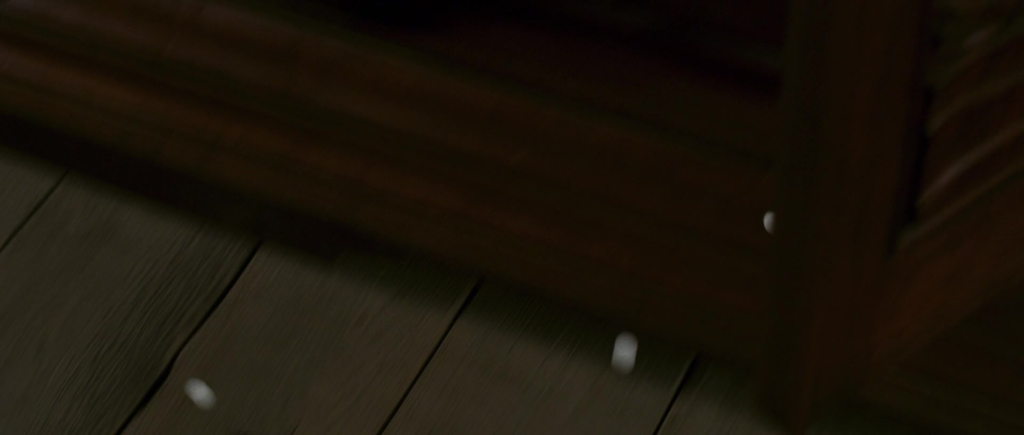
Less true to the book is the design of the wardrobe itself. C. S. Lewis described it as “the sort that has a looking glass in the door.” The movie’s wardrobe instead has ornate woodcarvings on the door. In another nod to the fandom, those woodcarvings are images from The Lion, the Witch and the Wardrobe‘s prequel, The Magician’s Nephew. You could argue that having the wardrobe look plainer would be more thematically appropriate, giving the message that It’s What Inside That Counts. But, as a fan for whom The Magician’s Nephew is the best Narnia book[4]Well, actually, it’s tied with The Horse and his Boy in my personal ranking., I adore this design. (And to be pedantic, Lewis wrote that the wardrobe was “the sort that has a looking glass in the door,” not that it did have one.)
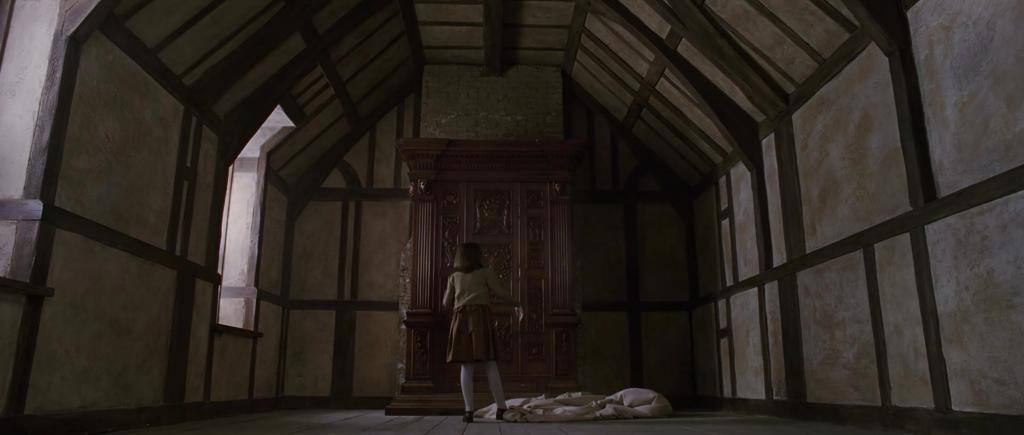
Lucy steps into the wardrobe, which is full of fur coats, leaving the door open a crack.[5]She also leaves the dustcloth outside, which means Peter could easily guess someone’s hiding in the wardrobe. Rookie mistake, Lu. She feels for the back of the wardrobe-only to prick her hand with a pine branch! She turns around and finds herself in a snowy forest. In the book, it’s also nighttime. I wish that could have been maintained since there are few things that look as magical to me as snow in the moonlight. But the movie’s version of the scene is quite a magical scene as it is.[6]And it’ll turn out there’s a storytelling reason behind the time change. A lot of the credit for that goes to Georgie Henley.[7]For this part, the director had her blindfolded on the set until the actual filming so that her character’s reaction to seeing everything for the first time would be as close to the real thing … Continue reading As Lucy, she has to carry many of the movie’s big emotional moments during the first third and at least a couple of big ones during the final third and she pulls them off wonderfully, especially considering how young she was at the time. Of course, credit for the scene’s beauty also belongs to the set design, the cinematography and the music. This is one of the best parts of the film’s soundtrack.
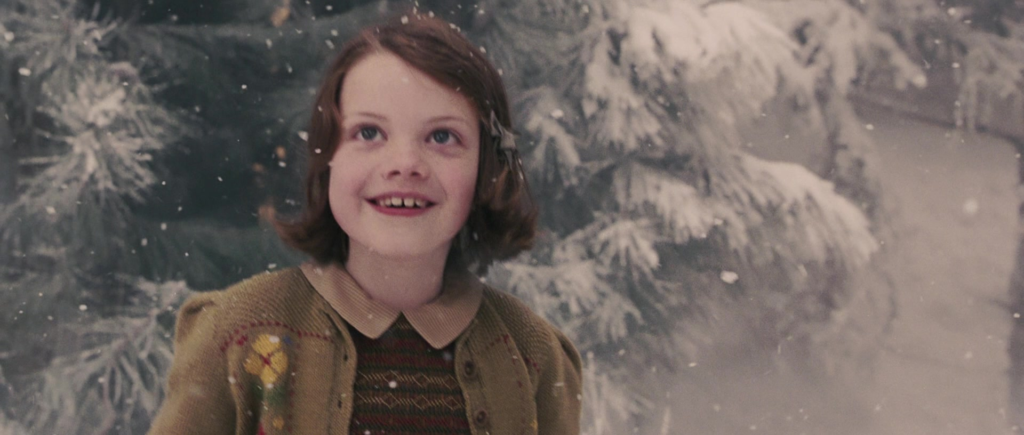
After looking back to make sure she can return to the wardrobe and the professor’s house, Lucy ventures into a clearing where she finds a flickering lamppost of all things. As she looks at it, the silence of the scene grows ominous. And then it’s not so silent as Lucy can hear strange footsteps coming. The scariness of the music gains a slightly over-the-top quality at this point though, which I think clues viewers in that this is the buildup to a funny moment.
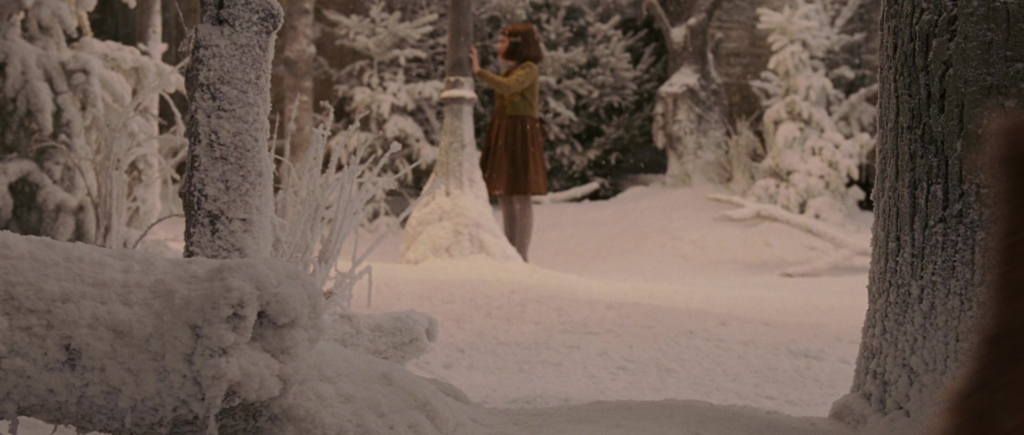
Sure enough, around a corner comes a faun (James McAvoy) carrying some parcels and an umbrella.[8]If you don’t know what a faun is, I’m afraid you’ll have to google it. These posts are slow paced enough without me defining every mythical creature. Both Lucy and the faun scream at the sight of each other and dive for cover. Then they cautiously emerge and approach each other. Well, Lucy does anyway. This faun is one of the most iconic characters, if not really one of the most developed, in Narnia and the movie’s depiction stays pretty true to the book’s description. Goat legs. Curly hair and short pointed beard. Horns on the forehead. Red woolen muffler. Umbrella. Brown paper parcels. The movie also has him carry a couple of bottles, possibly of some kind of ale, which isn’t from the book but fits very well with its description. It also gives the character goatlike ears which I find goofy but thankfully not too distracting. C. S. Lewis also gave his fauns long tails, something not characteristic of traditional depictions of them. The movie ignores this, going for the more typical goat tail. It’s also worth noting that the Narnia books describe fauns as having reddish skin and roughly the height of children. Few adaptations of them keep this and neither do the movies.[9]The 1979 made-for-TV cartoon of The Lion, the Witch and the Wardrobe is the only one I can think of that tries to replicate that part of the books’ descriptions. Of course, it also gives the … Continue reading But none of those little nitpicks really bother me when I watch this adaptation, only when I really stop to think about it. On the whole, the movie’s version of this character looks and feels quintessentially Narnian. And the computer-generated faun legs are one of the special effects team’s greatest achievements in that it never occurs to me that they’re CG while I’m watching.
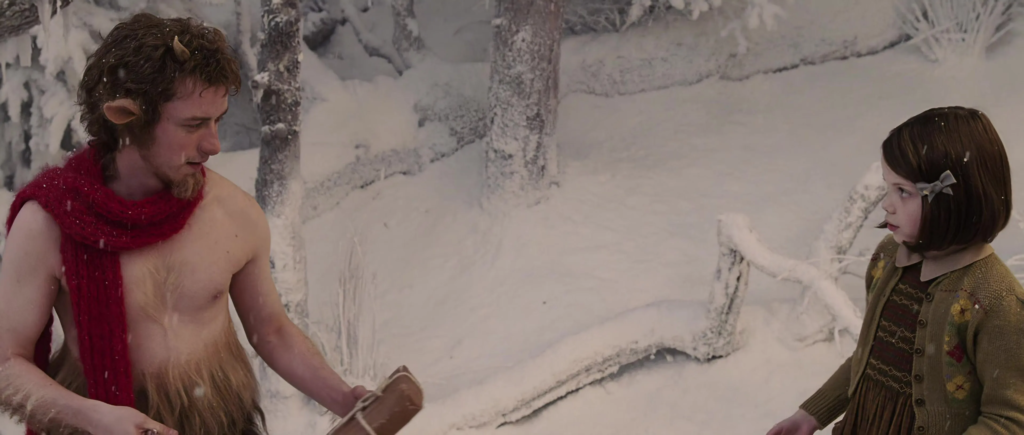
It helps that James McAvoy and Georgie Henley develop a nice friendly chemistry in the ensuing scene which is one of the most well written in the film, especially when it comes to humor.
Lucy: If you don’t mind my asking, what are you?
Faun: Well, I’m-I’m a faun. (defensively) And what are you? You must be some sort of beardless dwarf?
Lucy (indignantly): I’m not a dwarf! I’m a girl! And actually I’m the tallest in my class.
Faun: Do you mean to say that you are a daughter of Eve?
Lucy: My mum’s name is Helen.
Lucy’s failure to pick up on the faun’s awe and fear on learning her species/gender is great. After clarifying that she’s human, he breathlessly asks what she’s doing there. “Well, I was hiding in the wardrobe in the spare room,” Lucy begins. “Spare Oom?” interjects the faun. “Is that in Narnia?” I know I just praised this scene’s humor, but I’ve got to say that little misunderstanding was funnier in the book. (“If only I had worked harder at geography when I was a little Faun, I should no doubt know all about those strange countries.”) Lucy asks what Narnia is and the faun explains that it’s where the country where they’re standing, “everything from the lamppost all the way to the castle Cair Paravel on the eastern ocean.” Amusingly, as Lucy takes in the landscape, she murmurs, “this is an awfully big wardrobe.” (Lucy says a similar line in the book but that’s before she sees Narnia.)
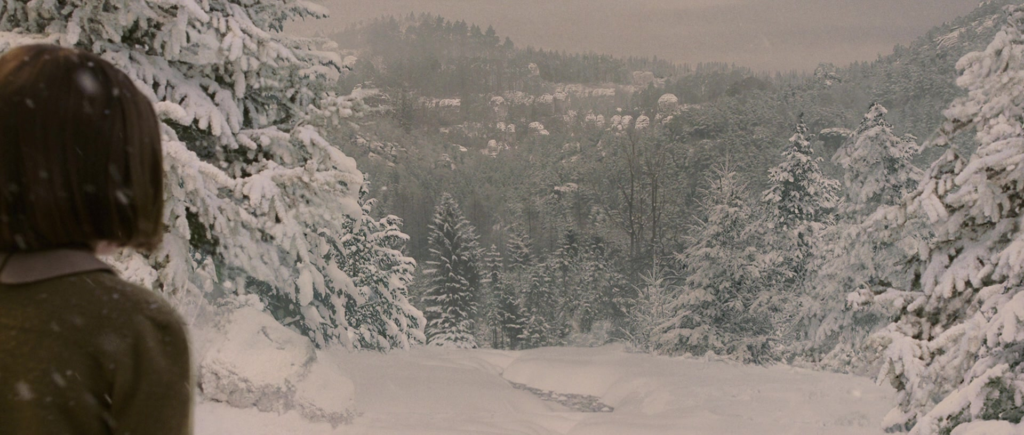
The faun introduces himself as Tumnus. Lucy tells him her name and holds out her hand for him to shake but he doesn’t know what to do with it. When she tries to explain, she has to admit she really doesn’t understand the custom either and they both laugh. Your guess is as good as mine why Narnians would have so many things in common with English culture but not handshaking. This is still a cute moment. “Well, Lucy Pevensie from the shining city of War Drobe and the wondrous land of Spare Oom, how would it be if you came and had tea with me?” Lucy is charmed but hesitates, remembering her siblings back home who have no idea of her whereabouts. However, Tumnus-or Mr. Tumnus as Lucy politely calls him-convinces her with promises of toast and tea and sardines. “It’s not every day I get to make a new friend,” he says. That line is a bit overly cute for my taste but oh well.[10]On reflection, given what we soon learn about the land of Narnia, it could be an indication of how sadly isolated it is from the rest of the world. As in the book, the two of them walk off together arm in arm, going from a woody area and to a more mountainous one and Tumnus leads Lucy to his door which is directly in a mountain. Once she’s inside, he looks around the area warily before going in himself and locking the door.
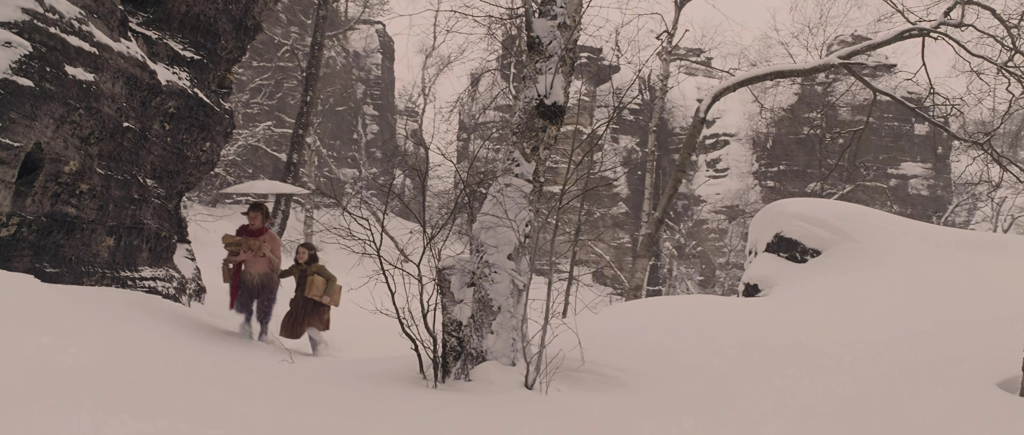
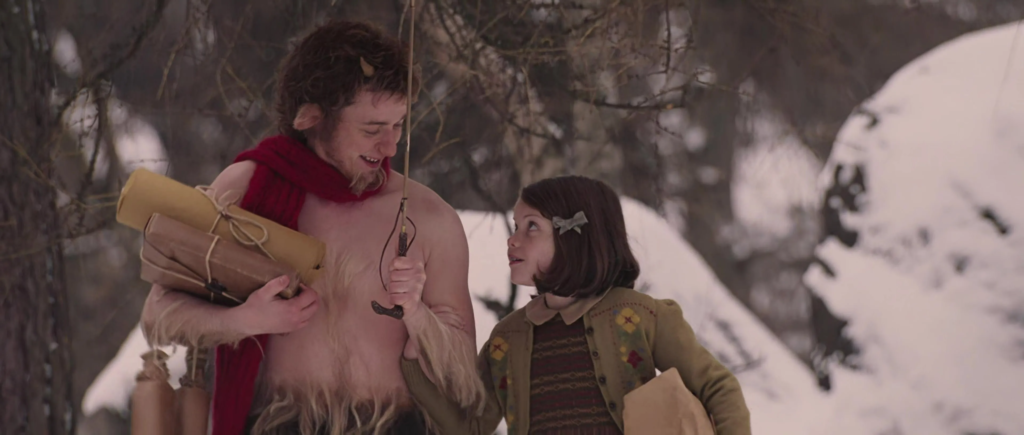
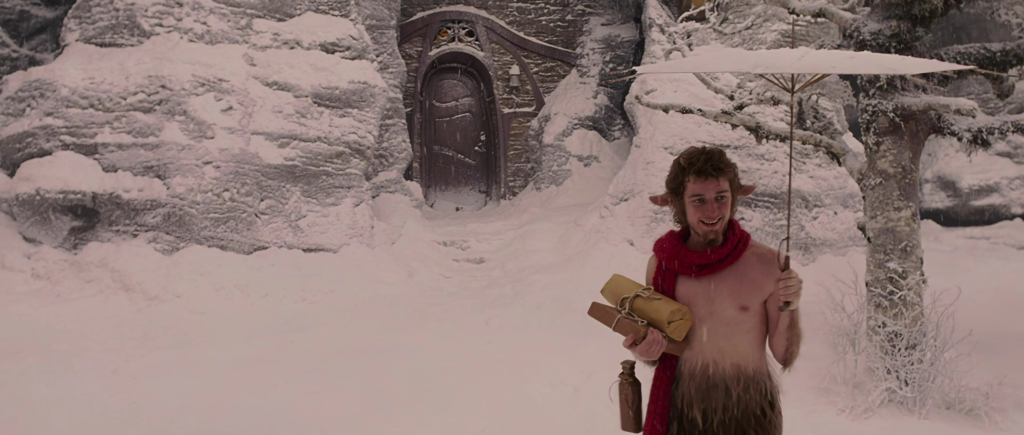
Props to production designer Roger Ford. Tumnus’s cave is charming and looks just like the book describes. When Lucy scans the bookshelf, I was pleased to even see some of the titles C. S. Lewis mentioned.
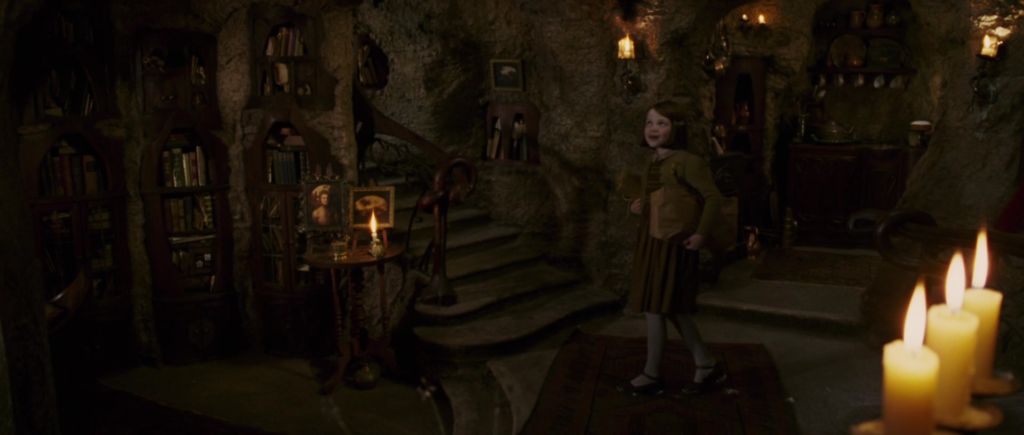
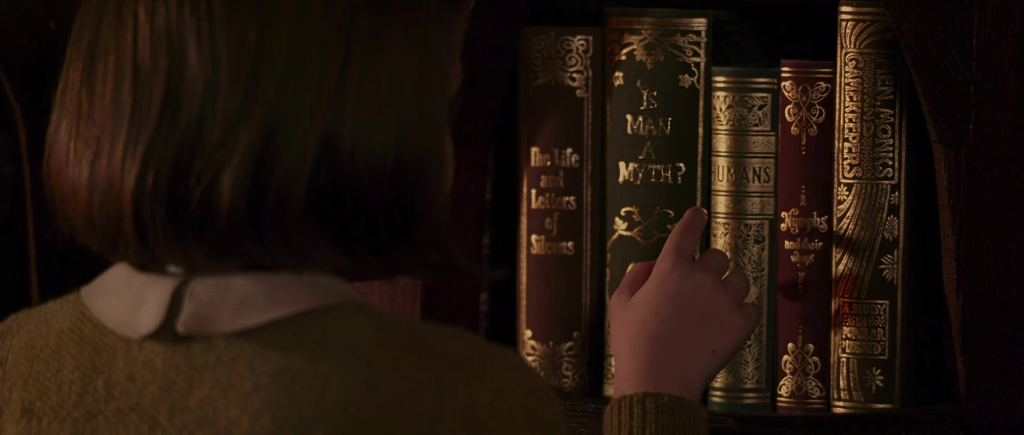
While Tumnus prepares the tea things, he notices Lucy looking at a painting of an old faun whom he explains was his father. “He looks a lot like you,” says Lucy. “I’m not very much like him at all really,” Tumnus says sadly. When Lucy mentions her father’s fighting in the war, he tells her his also went to war, a detail that’s not from the book but which fits in with what the book implies about Tumnus’s father. “That was a long, long time ago,” he says, “before this dreadful winter.” I like that in this version of the story Lucy counters that winter has its good points like ice-skating, snowball fighting and Christmas. Tumnus sadly tells her that for a century Narnia has been in a state of winter without Christmas, much like North Dakota in April. “But you would have loved Narnia in the summer,” he says as they sit down by the fire and he pours her refreshment. “We fauns danced with the dryads all night and, you know, we never got tired. And the music! Ah, such music! Would you like hear some now?” In the book, Tumnus’s stories about Narnia in the summer are implied to be a lot longer and more detailed than that but I can understand the pacing reasons they had to be trimmed for the film. Anyway, Tumnus takes out a panpipe and plays a lullaby.
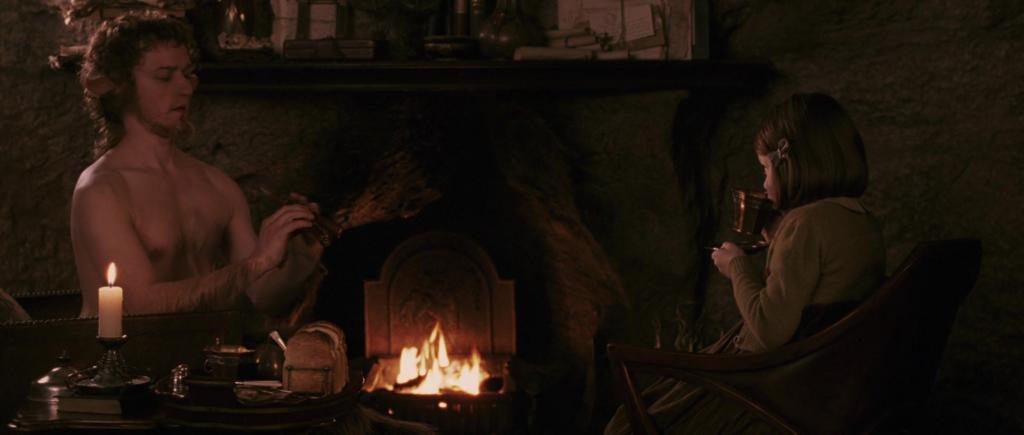
According to C. S. Lewis, “the tune he played made Lucy want to cry and laugh and dance and go to sleep all at the same time.” It’s doubtful any music could live up to that specific description but what composer Harry Gregson-Williams does is pretty awesome in its own way. The tune Tumnus plays sounds soothing enough that you can easily understand it working as a lullaby, granting that Lucy probably wouldn’t realistically nod off as soon as she does if there weren’t magic involved, but it also a sinister undertone that intensifies as the scene proceeds and the viewers become more aware of Tumnus’s malign intent. The movie tries to compensate for cutting the faun’s more specific descriptions of Narnian life from the book by having him (apparently) conjure up images of them in the fire. I don’t think anyone who hasn’t read the source material will understand what they’re supposed to be but it’s still pretty cool.
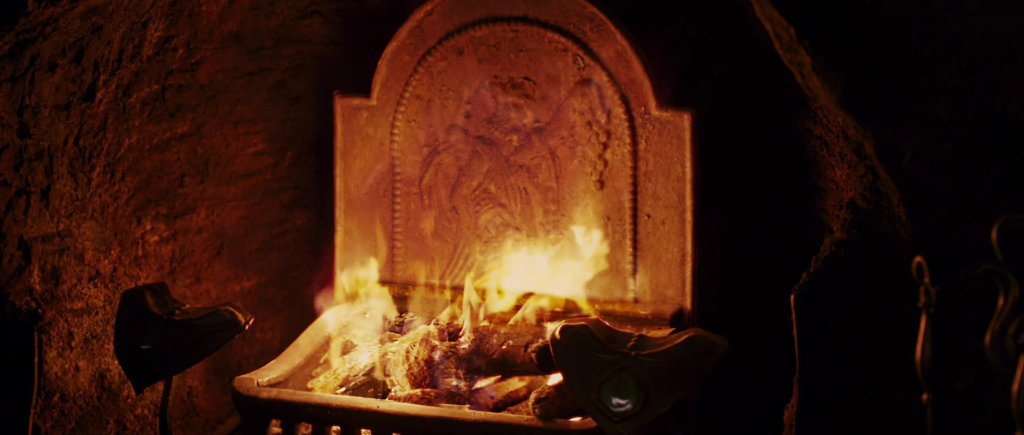
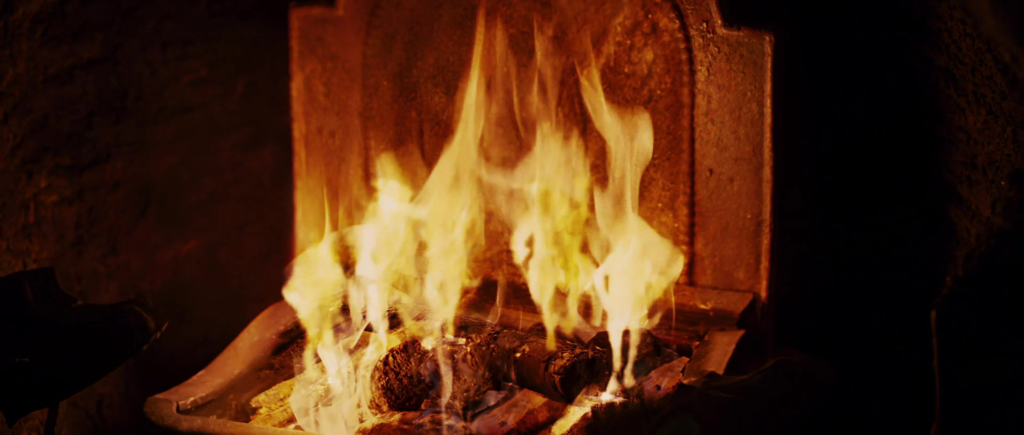
As Lucy falls asleep, Tumnus glances at the flames and suddenly the whole fire takes the shape of a lion’s head that roars angrily at him. Then every fire and therefore every source of light within the cave is extinguished. The movie never gives any explanation for what just happened though we can make educated guesses once we actually meet a lion later in the story. It’s a great moment in any case.
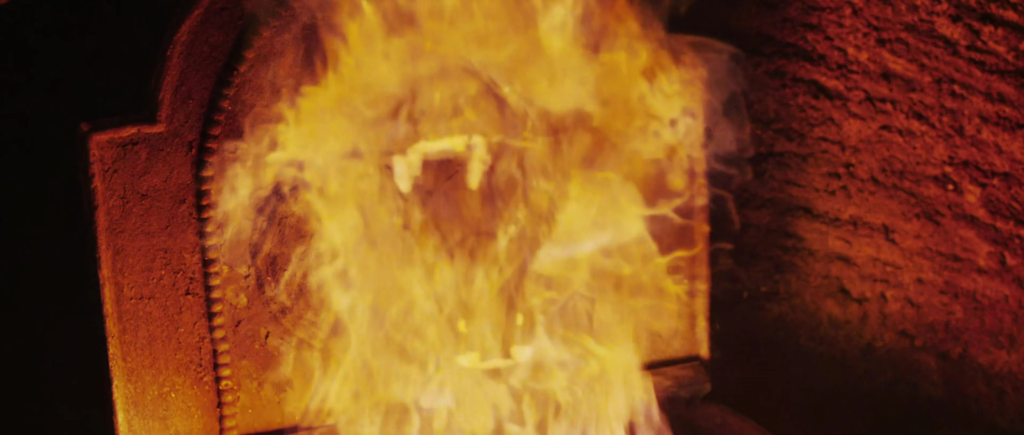
Lucy wakes up to see that it’s dark outside the window. “Oh, I should go,” she says. “Too late for that now,” says a voice. Lucy turns, startled, to see Tumnus curled up in a ball. Apparently, he’s been weeping for some time. In the book, he cries for a comically long time “so that presently Lucy was standing in a damp patch.” I actually think what the movie does works better, feeling creepier and less ridiculous.
Tumnus: I’m such a terrible faun!
Lucy: Oh no, you’re the nicest faun I’ve ever met!
Tumnus: Then I’m afraid you’ve had a very poor sampling.
Lucy (handing him a handkerchief): You can’t have done anything that bad.
Tumnus: It’s not something I have done, Lucy Pevensie. It’s something I am doing.
Lucy (doesn’t like the sound of that): What are you doing?
Tumnus: I’m kidnapping you. It was the White Witch! She’s the one who makes it always winter, always cold. She gave orders if any of us find a human wandering in the woods, we’re supposed to turn it over to her.
Lucy: Mr. Tumnus, you wouldn’t.
Mr. Tumnus’s guilty silence says apparently he would.
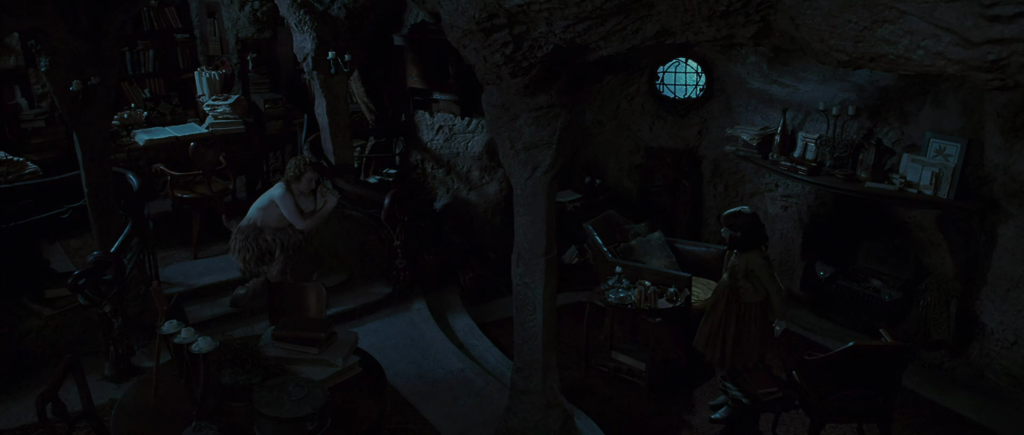
“I thought you were my friend,” says Lucy. I feel like she’s a little too cute in that moment. Actually, if I have a criticism with this generally great part of the movie/adaptation, it’s that it feels more like we’re supposed to be looking down at Lucy and going, “aww, how cute,” whereas in the book, we see things from her perspective and regard her as an equal during this scene anyway. That may be an inevitable side effect of the visual medium. Since I’m an adult now and even when the movie was released, I was older than Lucy, there’s no way I’m not going to notice the age gap between us as I watch. In the book, it’s easier to forget about things like that while reading. It’s also probably because Georgie Henley was the only one of the actors playing the Pevensies who was around the same age as her character in the book, the others being all teenagers at the time, so her youth stands out more.
Anyway, Tumnus looks at Lucy, then looks down at her handkerchief, then makes a decision. He takes Lucy by the arm and runs with her back to the lamppost. “The woods are full of her spies,” he warns her, “even some of the trees are on her side!” They reach the lamppost. “Can you find your way back from here?” he asks. “I think so,” says Lucy, “will you be all right?” Tumnus bursts out crying again, and Lucy again tries to comfort him. This is a bit of a change from the book where he goes into some detail about how the White Witch will punish him if she finds out about his disobedience. The book explains all of the Witch’s most terrible powers as soon as she’s introduced[11]Though not her role of executioner which will be very important towards the end of the story. whereas the movie chooses to slowly build them up. Embarrassed, Tumnus hands Lucy back her crumpled-up handkerchief. “Keep it,” she says, “you need it more than I do.” Tumnus assures Lucy that no matter what happens to him, he’s glad he met her, saying, “you’ve made me feel warmer than I’ve felt in a hundred years.” This clarifies something the book doesn’t, that Tumnus was actually alive before the White Witch’s winter. In the text, it’s possible that the stories he tells Lucy about Narnia before then were passed down through the generations but it’s also possible Tumnus, despite his apparently youthful appearance, was really over a hundred years old.[12]C. S. Lewis didn’t actually specify that the winter lasted that long until the book’s sequel, Prince Caspian, so it’s possible he didn’t originally intend it when writing The … Continue reading After a final goodbye, Lucy runs off into the thicket from whence she came.
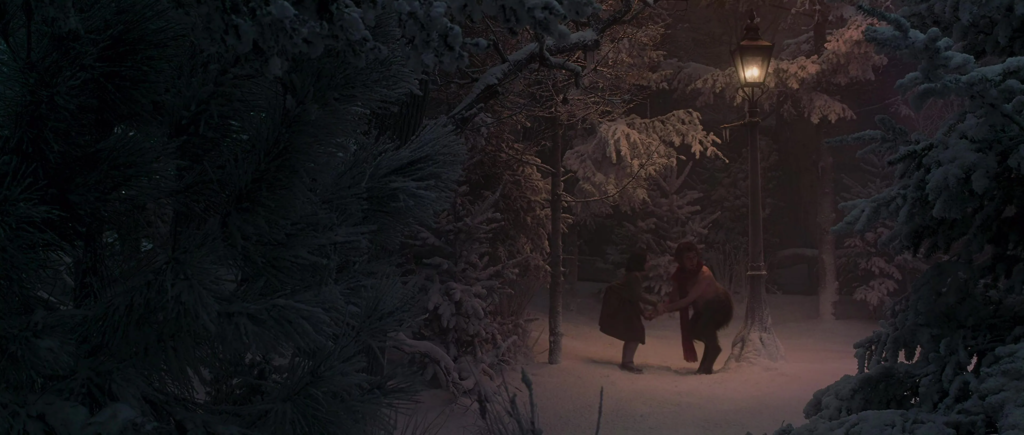
Next Week: Edmund Also Goes to Narnia and Receives Some Refreshment.
References
| ↑1 | And, incidentally, I have to praise the movie for getting right that some of the Pevensies have dark hair and some golden hair even though it’s supposed to be Lucy with the latter, not Peter. |
|---|---|
| ↑2 | Though you could also argue that it’s thematically significant that Lucy is the only one of her siblings who thinks it worth looking in something so seemingly plain and ordinary. |
| ↑3 | Longtime readers of this blog may have already heard of them. |
| ↑4 | Well, actually, it’s tied with The Horse and his Boy in my personal ranking. |
| ↑5 | She also leaves the dustcloth outside, which means Peter could easily guess someone’s hiding in the wardrobe. Rookie mistake, Lu. |
| ↑6 | And it’ll turn out there’s a storytelling reason behind the time change. |
| ↑7 | For this part, the director had her blindfolded on the set until the actual filming so that her character’s reaction to seeing everything for the first time would be as close to the real thing as possible. It paid off. |
| ↑8 | If you don’t know what a faun is, I’m afraid you’ll have to google it. These posts are slow paced enough without me defining every mythical creature. |
| ↑9 | The 1979 made-for-TV cartoon of The Lion, the Witch and the Wardrobe is the only one I can think of that tries to replicate that part of the books’ descriptions. Of course, it also gives the fauns green hair so points off for that. |
| ↑10 | On reflection, given what we soon learn about the land of Narnia, it could be an indication of how sadly isolated it is from the rest of the world. |
| ↑11 | Though not her role of executioner which will be very important towards the end of the story. |
| ↑12 | C. S. Lewis didn’t actually specify that the winter lasted that long until the book’s sequel, Prince Caspian, so it’s possible he didn’t originally intend it when writing The Lion, the Witch and the Wardrobe. On the other hand, The Last Battle mentions that Narnian centaurs and, to a lesser extent, unicorns live a long time so it’s reasonable to imagine that fauns do too. |
